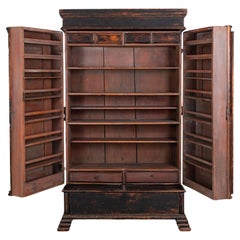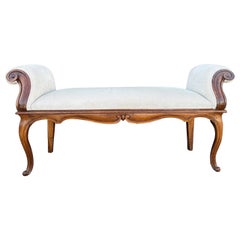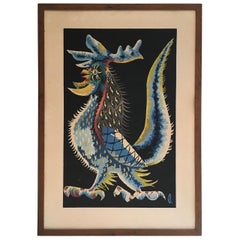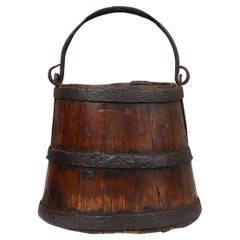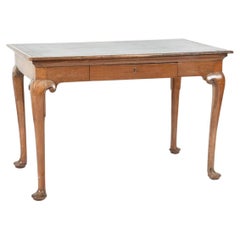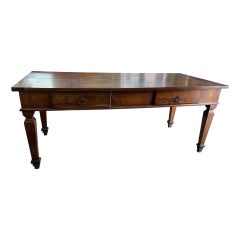Wood Furniture
to
1,933
8,980
7,876
17,325
2,324
1,922
1,037
1,021
946
577
137
126
73
63
46
31
11
8
7
5
3
17,325
53,491
152,382
70,132
23,174
82,038
28,578
3,800
1,180
4,119
6,594
6,633
18,716
23,777
14,715
4,829
1,889
17,325
8,316
6,921
4,913
4,002
14,716
4,037
3,796
3,339
3,037
17,325
17,325
17,325
234
37
11
9
6
Period: 18th Century and Earlier
Material: Wood
Black Swedish Cupboard or Kitchen Cabinet, Sweden Late 18th C.
Located in South Salem, NY
A late 18th-century Swedish Baroque cupboard or storage kitchen cabinet, showcasing timeless craftsmanship and practicality. This striking piece features dry-scraped historic black p...
Category
Mid-18th Century Swedish Baroque Antique Wood Furniture
Materials
Pine
18th Century Italian Baroque Walnut Bench
Located in Houston, TX
18th Century Italian Baroque Walnut Bench.
Offered is a handsome 18th century Italian Baroque walnut bench from the Tuscany region of Italy that has graceful arms which is profession...
Category
18th Century Italian Baroque Antique Wood Furniture
Materials
Velvet, Walnut
Rooster Printing, French Work Signed by Jean Lurçat. Circa 1970
By Jean Lurçat
Located in Marcq-en-Barœul, Hauts-de-France
This rooster printing is a work signed by French designer Jean Lurçat. Circa 1970.
Category
1770s French Mid-Century Modern Antique Wood Furniture
Materials
Wood, Paper
Handmade French wooden bucket from the 18th century
Located in Meulebeke, BE
A rare antique wooden bucket from the 18th century. Handmade in France in hardwood with ironwork. This bucket is made of wooden staves and a bas...
Category
18th Century French Antique Wood Furniture
Materials
Iron
18th Century George II Walnut Writing Table
Located in Bradenton, FL
George II walnut writing table, Mid-18th Century, the molded top having a tooled green leather inset writing panel, fitted with a genuine and false frieze drawer to either side, rais...
Category
18th Century British George II Antique Wood Furniture
Materials
Walnut, Leather
18th Century Italian Walnut Neoclassical Farm Table / Kitchen Table
Located in Carmine, TX
Kitchen table hand-made in Italy in the late 1700s using walnut and pegged construction. The table is extremely well-built and solid, despite having very elegant proportions and line...
Category
Late 18th Century Italian Neoclassical Antique Wood Furniture
Materials
Walnut
Monumental Ebonized Venetian Hand Carved Armchair, circa 1780 by Fratelli Mora
Located in Vigonza, Padua
Important ebonized Baroque Venetian armchair, circa 1780 Fratelli Mora.
Produced by Fratelli Mora in Bergamo, factory established in 1778. At that time the main production was made ...
Category
Late 18th Century Baroque Antique Wood Furniture
Materials
Walnut
Extraordinary Italian Parquetry Bureau Cabinet Trumeaux Rome, 1740
Located in Rome, IT
Outstanding Italian 18' century walnut, parquetry bureau cabinet fruitwood inlaid with scrolling foliage,
The upper section with a shaped carved cresting centered by a cartouche-sha...
Category
Early 18th Century Italian Baroque Antique Wood Furniture
Materials
Wood, Walnut
18th Century Austrian Historical Large Antique Sprucewood Two-Part Cabinet
Located in West Palm Beach, FL
A 18th Century, antique two-part cabinet from the Baroque period, Maria - Theresia furniture. The Austrian furniture originates from a noble manor house, made of hand crafted Sprucewood and in good condition. The large buffet is accessible from all four sides. The top part is composed of an arched removable cupboard, resting on the wide commode. The interior consists of three double doors which can be opened from the front and backside with one small center drawer. The center of the lower part is consisting on each side four large drawers and on the side three drawers which are enhanced by round door knobs and handles...
Category
Mid-18th Century Austrian Baroque Antique Wood Furniture
Materials
Metal
Italian 18th Century Carved Giltwood Neo Classical Style bird Ornament
Located in Buisson, FR
Beautiful handcarved giltwood bird ornament.
Made out of wood with later chalk restorations.
Italy circa 1780 . Weathered, losses and old repairs.
Measurements individual and includ...
Category
18th Century Italian Neoclassical Antique Wood Furniture
Materials
Wood
Swedish 1770s Baroque Period Light Gray Painted Secretary with Slant Front Desk
Located in Atlanta, GA
A Swedish Baroque tall secretary from circa 1770, with slant front desk, light Gustavian gray painted finish, two doors and four drawers. Experience the timeless elegance of this Swedish tall secretary from circa 1770, a piece that seamlessly marries the grandeur of Baroque design with the serene simplicity of the Gustavian painted finish. Indeed, this secretary, with its light gray painted finish, two doors, and four drawers, is a testament to the refined craftsmanship and understated beauty of Nordic furniture.
The secretary's tall, imposing structure is softened by the light Gustavian gray finish, creating a sense of calm sophistication. The two doors, featuring simply carved panels, open to reveal an interior bathed in antique powder...
Category
Late 18th Century Swedish Baroque Antique Wood Furniture
Materials
Glass, Wood
18th Century, Italian Giltwood & Paint Decorated Planter - Mirrored Back
Located in Atlanta, GA
Italy, 18th century.
This magnificent 18th-century Italian planter is a captivating example of Rococo Baroque craftsmanship, featuring an elegant French blue painted background that...
Category
18th Century Italian Baroque Antique Wood Furniture
Materials
Mirror, Giltwood, Paint
Antique Bleached Serpentine Fronted Chest of Drawers, English C.1780
Located in St Annes, Lancashire
Wonderful commode or chest of drawers.
Bleached and lime washed tropical hardwood.
Lovely shaped serpentine front
Veneered drawer fronts. Some historical small patches on the draw...
Category
1780s English Baroque Antique Wood Furniture
Materials
Wood
French 18th Century Louis XVI Gilt & Painted Trumeau
Located in Baton Rouge, LA
A refined trumeau mirror of the Louis XVI period, dating to the 18th century France, with elegant, gilt wood carvings mounted on an ebonized back panel. Scrolled foliate carvings at ...
Category
18th Century French Louis XVI Antique Wood Furniture
Materials
Gold
Late 18th Century Harlequin English Lancashire Spindle-back Chairs Set of 4
Located in Louisville, KY
These mid 18th Century English Harlequin Lancashire chairs are an amazing reflection of a time when craftsmanship was uniquely individual, resulting i...
Category
Late 18th Century English Georgian Antique Wood Furniture
Materials
Rush, Oak, Ash, Elm
Original 18th Century Monumental Cabinet on Stand / Italian Bargueno / European
Located in Miami, FL
Important monumental cabinet on stand.
The case of the cabinet is walnut, veneered with rich rib boned ebony and luxuriously decorated with turtle ...
Category
Late 18th Century Italian Baroque Antique Wood Furniture
Materials
Walnut, Glass
Antique Charles II 17th Century Carved 8ft Oak Refectory Dining table 1680
Located in Portland, OR
Antique English carved oak refectory dining table, circa 1680.
A fine and large oak refectory table from the reign of King Charles II and the restoration of the monarcht after the En...
Category
1680s English Charles II Antique Wood Furniture
Materials
Oak
Late 18th Century French Louis XIV Style Hand Carved Walnut Commode or Chest
Located in Fayetteville, AR
This late-eighteenth century Louis XIV style hand carved walnut commode or chest of drawers was found in the region of Normandy, France. This piece features three drawers of dovetail...
Category
Late 18th Century French Louis XIV Antique Wood Furniture
Materials
Bronze
Japanese Antique Edo Hand Carved Wood Noh Theater Mask Otobide 17th-18th Century
Located in Studio City, CA
A truly beautiful, wonderfully aged, alluring mask made for Japanese Noh theater. The naturally faded beauty and unique character drew us to this mask immediately.
The mask is handcrafted and hand-carved from natural wood, clearly by a master of his trade.
We believe this mask is of the Noh theatre character Otobide.
This mask dates back to the Edo Period (1603-1868). It comes with a wooden storage box (which may have been added at a later date).
A rare, unique, and exquisite mask. Finely carved and executed. Would be a great addition to any Japanese or Asian art/artifacts collection or an eye-catching stand-alone accent piece in about any setting.
Mask dimensions: 7.7" high, 5.7" wide, 2.1" deep...
Category
18th Century Japanese Edo Antique Wood Furniture
Materials
Wood, Lacquer, Paint
18th Century Louis XV Kingwood Marquetry Commode
Located in West Palm Beach, FL
Outstanding example of 18th century Louis XV commode with beautiful marquetry work and exquisite marble top. This commode features five separate drawers with bronze ormolu mounts.
Category
Mid-18th Century French Louis XV Antique Wood Furniture
Materials
Kingwood
Cherry Tree Species Petrified Wood Cross Cut Slice Specimen
Located in Philadelphia, PA
A fine petrified wood specimen.
Perfect for use on the bar or table as a trivet.
An old collector's record indicates that it is a species of cherry from Mcdermitt, Oregon.
...
Category
15th Century and Earlier North American Antique Wood Furniture
Materials
Petrified Wood
Rare and important painted bronze Crucifix after a model by Michelangelo
By Michelangelo Buonarroti
Located in Leesburg, VA
A rare and very fine bronze corpus of Christ after a model by Michelangelo, cast ca. 1597-1600 by Juan Bautista Franconio and painted in 1600 by Francisco Pacheco in Seville, Spain.
The present corpus reproduces a model attributed to Michelangelo. The best known example, lesser in quality, is one on display at the Metropolitan Museum of Art (MET).
The association of this corpus with Michelangelo was first brought to light by Manuel Gomez-Moreno (1930-33) who studied the wider circulated casts identified throughout Spain. The attribution to Michelangelo was subsequently followed by John Goldsmith-Phillips (1937) of the MET and again by Michelangelo expert, Charles de Tolnay (1960).
While Michelangelo is best known for his monumental works, there are four documented crucifixes he made. The best known example is the large-scale wooden crucifix for the Church of Santa Maria del Santo Spirito in Florence, made in 1492 as a gift for the Prior, Giovanni di Lap Bicchiellini, for allowing him to study the anatomy of corpses at the hospital there. In 1562, Michelangelo wrote two letters to his nephew, Lionardo, indicating his intention to carve a wooden crucifix for him. In 1563 a letter between Lionardo and the Italian sculptor Tiberio Calcagni, mentions this same crucifix (a sketch of a corpus on the verso of a sheet depicting Michelangelo’s designs for St. Peter’s Basillica [Palais des Beaux-Arts in Lille] may reproduce this). That Michelangelo was working on small corpora in the last years of his life is further evidenced by the small (26.5 cm) unfinished wooden crucifix located at the Casa Buonarroti, considered his last known sculptural undertaking. Michelangelo’s contemporary biographer, Giorgio Vasari additionally cites that Michelangelo, in his later years, made a small crucifix for his friend, Menighella, as a gift.
Surviving sketches also indicate Michelangelo’s study of this subject throughout his career, most notably during the end of his life but also during the 1530s-40s as he deepened his spiritual roots. The occasional cameo of crucified Christ’s throughout his sketched oeuvre have made it challenging for scholars to link such sketches to any documented commissions of importance. All the while, in consideration that such objects were made as gifts, it is unlikely they should be linked with commissions.
Nonetheless, a number of theories concerning Michelangelo’s sketches of Christ crucified have been proposed and some may regard the origin of the present sculpture. It has been suggested that the corpus could have its impetus with Michelangelo’s work on the Medici Chapel, whose exclusive design was given to the master. It is sensible smaller details, like an altar cross, could have fallen under his responsibility (see for example British Museum, Inv. 1859,0625.552). Others have noted the possibility of an unrealized large marble Crucifixion group which never came to fruition but whose marble blocks had been measured according to a sheet at the Casa Buonarroti.
A unique suggestion is that Michelangelo could have made the crucifix for Vittoria Colonna, of whom he was exceedingly fond and with whom he exchanged gifts along with mutual spiritual proclivities. In particular, Vittoria had an interest in the life of St. Bridget, whose vision of Christ closely resembles our sculpture, most notably with Christ’s proper-left leg and foot crossed over his right, an iconography that is incredibly scarce for crucifixes. The suggestion could add sense to Benedetto Varchi’s comment that Michelangelo made a sculpted “nude Christ…he gave to the most divine Marchesa of Pescara (Vittoria Colonna).”
Of that same period, two sketches can be visually linked to our sculpture. Tolnay relates it to a sketch of a Crucified Christ at the Teylers Museum (Inv. A034) of which Paul Joannides comments on its quality as suggestive of preparations for a sculptural work. Joannides also calls attention to a related drawing attributed to Raffaello da Montelupo copying what is believed to be a lost sketch by Michelangelo. Its relationship with our sculpture is apparent. Montelupo, a pupil of Michelangelo’s, returned to Rome to serve him in 1541, assisting with the continued work on the tomb of Pope Julius II, suggesting again an origin for the corpus ca. 1540.
The earliest firm date that can be given to the present corpus is 1574 where it appears as a rather crudely conceived Crucifixion panel, flanked by two mourners in low-relief and integrally cast for use as the bronze tabernacle door to a ciborium now located at the Church of San Lorenzo in Padula. Etched in wax residue on the back of the door is the date, 27 January 1574, indicating the corpus would have at least been available as a model by late 1573.
The Padula tabernacle was completed by Michelangelo’s assistant, Jacopo del Duca and likely has its origins with Michelangelo’s uncompleted tabernacle for the Basilica of St. Mary of the Angels in Rome.
The impetus for the Padula tabernacle’s Crucifixion panel begins with a series of late Crucifixion sketches by Michelangelo, depicting a scene of Christ crucified and flanked by two mourners (see British Museum Inv. 1895.0915.510; Ashmolean Museum Inv. 1846.89, KP II 343 recto; Windsor Castle RCIN 912761 recto; and Louvre Inv. 700). A faintly traced block possibly intended for sculpting the sketch of the crucified Christ on its recto was discovered by Tolnay on a version of the composition at Windsor Castle. The Windsor sketch and those related to it appear to have served as preparatory designs for what was probably intended to become the Basilica of St. Mary’s tabernacle door. Vasari documents that the project was to be designed by Michelangelo and cast by his assistant, Jacopo del Duca. Michelangelo died before the commission was complete, though on 15 March 1565, Jacopo writes to Michelangelo’s nephew stating, “I have started making the bronze tabernacle, depending on the model of his that was in Rome, already almost half complete.” Various circumstances interrupted the completion of the tabernacle, though its concept is later revitalized by Jacopo during preparations to sell a tabernacle, after Michelangelo’s designs, to Spain for Madrid’s El Escorial almost a decade later. The El Escorial tabernacle likewise encountered problems and was aborted but Jacopo successfully sold it shortly thereafter to the Carthusians of Padula.
An etched date, 30 May 1572, along the base of the Padula tabernacle indicates its framework was already cast by then. A 1573 summary of the tabernacle also describes the original format for the door and relief panels, intended to be square in dimension. However, a last minute decision to heighten them was abruptly made during Jacopo’s negotiations to sell the tabernacle to King Phillip II of Spain. Shortly thereafter the commission was aborted. Philippe Malgouyres notes that the Padula tabernacle’s final state is a mixed product of the original design intended for Spain’s El Escorial, recycling various parts that had already been cast and adding new quickly finished elements for its sale to Padula, explaining its unusually discordant quality, particularly as concerns the crudeness of the door and relief panels which were clearly made later (by January 1574).
Apart from his own admission in letters to Spain, it is apparent, however, that Jacopo relied upon his deceased master’s designs while hastily realizing the Padula panels. If Michelangelo had already earlier conceived a crucifix model, and Jacopo had access to that model, its logical he could have hastily employed it for incorporation on the door panel to the tabernacle. It is worth noting some modifications he made to the model, extending Christ’s arms further up in order to fit them into the scale of the panel and further lowering his chin to his chest in order to instill physiognomic congruence. A crude panel of the Deposition also follows after Michelangelo’s late sketches and is likewise known by examples thought to be modifications by Jacopo based upon Michelangelo’s initial sculptural conception (see Malgouyres: La Deposition du Christ de Jacopo del Duca, chef-d’oeuvre posthume de Michel-Ange).
Jacopo’s appropriation of an original model by Michelangelo for more than one relief on the Padula tabernacle adds further indication that the crucifix was not an object unique to Jacopo’s hand, as few scholars have posited, but rather belongs to Michelangelo’s original...
Category
16th Century Renaissance Antique Wood Furniture
Materials
Bronze
18th Century Italian Walnut Neoclassical Commode / Chest of Drawers
Located in Carmine, TX
Neoclassical commode / chest of drawers hand-made in Italy in the late 1700s using walnut and decorated with walnut inlaid veneer. The chest features three overlay drawers with beaut...
Category
Late 18th Century Italian Neoclassical Antique Wood Furniture
Materials
Walnut
Late 18th Century Pair of Neoclassical Bedside Tables
Located in Atlanta, GA
This refined pair of late 18th-century Italian bedside tables exemplifies the elegance and balance of neoclassical design. Masterfully veneered in a beautiful combination of walnut a...
Category
Late 18th Century Italian Antique Wood Furniture
Materials
Olive, Walnut
17th Century Japanese Screen. Ink Plum Tree & Birds by Kano Naonobu.
Located in Kyoto, JP
Kano Naonobu (1607-1650)
Plum Tree and Birds
Six-fold Japanese Screen. Ink and slight color on paper.
In this evocative ink work spread over a six-panel folding screen, we see the consummation of the elegance and refinement of the Edo Kano school. This 17th century screen is a rare surviving example of a large-scale bird and flower painting by Kano Naonobu, the younger brother of Kano Tanyu...
Category
17th Century Japanese Edo Antique Wood Furniture
Materials
Wood, Paper
Late 17th Century Oak Paneled Room 3 Walls 2 Doors
Located in Huntington, NY
Late 17th century oak paneled room 3 walls, 2 doors.
Exceptional faded oak color and patina. Would make a great office
or dressing room. We c...
Category
17th Century French Louis XIV Antique Wood Furniture
Materials
Wood
Contemporary Red Lacquered and Ornate Asian Storage and Filing Cabinet on Stand
Located in Germantown, MD
A Contemporary Red Lacquered and Ornate Asian Storage cabinet or Filing Cabinet on Stand. Inside Felt lined and stand top. Very good vintage condition. comes with removable filing ra...
Category
Early 17th Century Unknown Chinese Export Antique Wood Furniture
Materials
Felt, Hardwood, Lacquer
18th late Italian half Round console
Located in Ballard, CA
Italian Baroque style walnut demi lune console table from the 18th century, with semi-circular top, carved legs and cross stretcher. this Baroque table or console is in excellent...
Category
1780s Italian Baroque Antique Wood Furniture
Materials
Walnut
18th Century Italian Rococo Carved Frieze Wall Panel - Antique Oakwood Door
Located in West Palm Beach, FL
An antique Italian frieze panel with flowers, vines and leaves, made of hand crafted Oakwood in good condition. The vertical door features two hand crafted round metal door pulls...
Category
Late 18th Century Italian Rococo Antique Wood Furniture
Materials
Oak
Boston Queen Ann Mahogany Slip Seat Side Chair, 1710-20
Located in Kenilworth, IL
American Queen Anne old growth mahogany upholstered slip seat side chair. The square seat is fitted to a conforming scolloped profile frame on cabriole legs ...
Category
1710s American Queen Anne Antique Wood Furniture
Materials
Upholstery, Mahogany
18th Century French Oak Farm Table / Dining Table
Located in Carmine, TX
Farm table hand-made in France in the mid 1700s using oak and pegged construction. The table has a beautiful warm color and great proportions. Measuring more than 2 mt in length this...
Category
Mid-18th Century French Rustic Antique Wood Furniture
Materials
Oak
French Early 18th Century Sofa
Located in Stockbridge, GA
French early 18th century sofa.
Category
Early 18th Century French Regency Antique Wood Furniture
Materials
Walnut
18th Century French Louis XV Walnut Carved Wardrobe or Armoire
Located in Casale Monferrato, IT
Rare and important antique wardrobe in solid walnut made in the late 18th century French Louis XV.
Characteristic wavy line with wood carvings on the floral taste front. Beautiful c...
Category
1780s French Louis XV Antique Wood Furniture
Materials
Walnut
English 18th Century Georgian Mahogany Chippendale Lowboy.
Located in Vero Beach, FL
English 18th Century Georgian Mahogany Chippendale Lowboy.
Circa 1780 George III period lowboy. Well figured mahogany. The lowboy, with a central arch kneehole, is designed with fou...
Category
18th Century English George III Antique Wood Furniture
Materials
Mahogany
Late 17th Century French Walnut Cabinet with Marble Top, Secret Compartments
Located in Fayetteville, AR
This late seventeenth century French Louis XIV period walnut cabinet features a Saint Anne marble top and solid paneled sides. A single symmetrical paneled door at the front opens to...
Category
Late 17th Century French Antique Wood Furniture
Materials
Marble
18th Century Swedish Gustavian Pair of Gilded Wood Wall Glass Mirrors
Located in West Palm Beach, FL
A gold, antique Swedish Gustavian pair of wall mirrors made of hand crafted gilded wood with its original mirrored glass, in good condition. The Scandinavian wall décor...
Category
18th Century Swedish Gustavian Antique Wood Furniture
Materials
Glass, Giltwood, Mirror
18th Century Diptych Portable Sundial And Compass by German Beringer
Located in Milano, MI
Antique 18th Century Diptych Sundial and Compass a portable wooden boxwood sundial with compass, of German origin, by David Beringer, Nuremberg, dating back to the 1790 circa, in good age related condition, with signs of wear consistent with age and use.
David Beringer (1756 – 1821) was a German scientific instrument maker and craftsman active in Nuremberg and famous for his cubic wooden sundials visible in Metropolitan Museum of Art di New York.
A portable sundial...
Category
Late 18th Century German Antique Wood Furniture
Materials
Brass
George II Japan Painted Tall Case Clock
Located in Huntington, NY
George II Japan painted tall case clock
This Yellow chinoiserie japan painted tall case clock with
It’s origanal 8 day movement with date & s...
Category
Mid-18th Century English George II Antique Wood Furniture
Materials
Brass
French 18th Century Marble-Top Louis XVI Console Table
Located in Buisson, FR
Beautiful marble-top Louis XVI console table. Wonderful carvings and great patina. Original marble top.
France, circa 1770-1889. Weathered and small losses.
More photo's are availab...
Category
18th Century French Louis XVI Antique Wood Furniture
Materials
Marble
Late 1700’s English Oak Barley Twist Bench with Heavy Carving
Located in Louisville, KY
This beautiful antique specimen reflects the creativity and personal pride taken by craftsman of this early era. Crafted in England during the late 18th century from oak, this piece ...
Category
Late 18th Century English Jacobean Antique Wood Furniture
Materials
Velvet, Oak
Spanish Alms Box / Wall Decoration with Carved Saints Detail, 18th Century
Located in Barcelona, ES
Carved wood hand painted donation / offering ALM Box, Spain, 18th century.
Polychromed carved wood church collection offering donation money box as wall decoration.
This alms box is made of pine wood painted in shades of blue and gray with carved saint figures onamentations decorating the top.
Wall hanging collection / donation money box. Originally used to collect donations at Christian churches/chapels. Interesting to be used as key box or key cabinet or as wall decoration
Rare find.
Provenance: Private collection.
No key avaliable.
Overall Measures:
Saints Box: 33 cm H x 37 cm W x 14 cm D
Poor...
Category
18th Century Spanish Medieval Antique Wood Furniture
Materials
Wood, Pine
18th Century Italian Neoclassical Painted Serpentine Commode
Located in West Palm Beach, FL
18th Century Italian Neoclassical Painted Serpentine Commode
Italy, 18th Century
A substantial chest of drawers with natural walnut serpe...
Category
18th Century Italian Neoclassical Antique Wood Furniture
Materials
Metal
William And Mary Oyster Burl Walnut Chest Of Drawers
Located in Bradenton, FL
William and Mary oyster veneer Chest of Drawers, late 17th/early 18thc. Great Burl decorated veneer rectangular top wit...
Category
Early 18th Century English William and Mary Antique Wood Furniture
Materials
Burl
18th Century American Hanging Cupboard
Located in Carmel, CA
This small country Chippendale cupboard is finely crafted. The22. pair of two raised panel doors with outer molding. The cupboard has crown molding and rests on a base with apron. The brass handle pull and hatch lock are original. The hinges are mortised. The interior paint is newly added.
Category
Late 18th Century American American Colonial Antique Wood Furniture
Materials
Oak
Portuguese Baroque Madonna and Child Sculpture, 17th Century
Located in Lisbon, PT
This late 17th-century Portuguese Baroque sculpture in polychromed wood depicts the Madonna holding the Christ Child, carved with exquisite detail and spiritual grace.
The Virgin is...
Category
Late 17th Century Portuguese Baroque Antique Wood Furniture
Materials
Gold Leaf
Pair of Swedish Gustavian Gilt and Painted Wood Armchairs
Located in Bradenton, FL
Beautiful Rare Pair of Swedish Gilt and Painted Wooden Armchairs, ca. 1790. Exquisitely carved scrolled and curved frame with distal part of each arm terminating into gilt eagle head...
Category
18th Century Swedish Gustavian Antique Wood Furniture
Materials
Textile, Wood
Louis XVI Bergere, C. 1790
Located in Doylestown, PA
A Louis XVI period bergere chair circa 1790 with arched back and fluted legs, recently upholstered in a striped fabric with loose cushion seat. Very nice scale. Excellent quality.
Category
18th Century French French Provincial Antique Wood Furniture
Materials
Beech
Dutch 18th Century Oak & Ebonized Armoire
Located in Baton Rouge, LA
A Dutch armoire made of solid oak from the 1700’s. This armoire has geometric paneling instead of the classic pillowed carvings of the similarly styled Dutch kussenkast...
Category
18th Century Dutch Other Antique Wood Furniture
Materials
Oak
Quebecois Armoire
Located in Greenwich, CT
A French-Canadian armoire in pine having two doors on a narrow case with an overhanging molded cornice, the doors each featuring rebated full door X-crosses in a rectangular surround...
Category
18th Century Canadian Louis XIV Antique Wood Furniture
Materials
Pine
Hand carved Japanese Jizai Kagi hearth hook, 1603-1867
Located in Kenilworth, IL
Japanese hand carved Jizai Kagi hearth hook in keyaki wood (Japanese Zelkova). The hook is presented on a custom forged metal stand.
Japan, Edo Period, 16...
Category
18th Century Japanese Antique Wood Furniture
Materials
Wood
Mid 18th Century carved pine dome top fitted cabinet
Located in Debenham, Suffolk
Fine quality English mid 18th century carved pine dome top fitted cabinet circa 1760.
Excellent quality piece that would have been fitted into a wall recess, with the outer frame fl...
Category
Mid-18th Century English Georgian Antique Wood Furniture
Materials
Pine
Georgian Mahogany Tilt-top Tea Table
Located in Wilson, NC
Georgian mahogany tilt-top tea table. A simple but elegant table with the original locking mechanism is in good working order.
Category
Mid-18th Century English Georgian Antique Wood Furniture
Materials
Mahogany
French 16th/ 17th Century Weathered Oak Renaissance Angel Fragment
Located in Buisson, FR
Beautiful weathered oak winged angel head Renaissance ornament.
France, 16/ 17th century. Weathered
Measurements include the wooden pedestal.
Category
16th Century French Renaissance Antique Wood Furniture
Materials
Oak
Spanish Chest with Arcade design
Located in Saint-Ouen, FR
SPANISH CHEST WITH ARCADE DESIGN
ORIGIN: SPAIN
PERIOD: LATE 15TH – EARLY 16TH CENTURY
DIMENSIONS:
Height: 61 cm
Length: 135 cm
Depth: 48 cm
Chestnut wood
Good condition
This H...
Category
16th Century Spanish Gothic Antique Wood Furniture
Materials
Wood, Chestnut
Antique Coffer, Large, English Oak Chest, Early 18th Century Trunk, circa 1700
Located in Hele, Devon, GB
This is an antique coffer, a large English oak chest or early 18th century trunk dating to circa 1700.
Substantial oak chest displaying rich, dark color
Pegged joint construction...
Category
Early 18th Century English Queen Anne Antique Wood Furniture
Materials
Oak
16th Century Period Renaissance Tuscan Walnut Credenzino
Located in Vero Beach, FL
16th Century Period Renaissance Tuscan Walnut Credenzino
Italian 16th/17th century Renaissance walnut small Credenza with a rectangular top above a single drawer centered over a s...
Category
16th Century Italian Renaissance Antique Wood Furniture
Materials
Walnut
18th Century French Provencal Pinewood Cabinet - Antique Demi-Lune Sideboard
Located in West Palm Beach, FL
A single, antique French Provencal sideboard in a light-blue, grey patina made of hand crafted painted Pinewood, in good condition. The demi-lune credenza has a rounded etched top, c...
Category
Mid-18th Century French French Provincial Antique Wood Furniture
Materials
Metal
Late 18th Century Swedish Painted Pull Out Bed
Located in Los Angeles, CA
Late 18th century very unusual, all original Swedish country house pull out bed. The original paint, applied with a traditional hand and comb painting technique, from natural pigments such as ochre browns, oxblood red and cobalt green, are still very much intact. Age appropriate wear have left a smooth patina around edges and seat. Wooden nails.
Bed can either be pulled out to desired depth, all the way to 49 inches or be left as a narrow bed...
Category
18th Century Swedish Rustic Antique Wood Furniture
Materials
Pine
Recently Viewed
View AllMore Ways To Browse
Airplane Air France
Andre Arbus Mirror
Angel Shelf
Anglo Botanical
Antique Baking Dish
Antique Brown Borneo
Antique Italian Wine Bottles
Antique Lead Soldier
Antique Stone Steps
Arched Church Doors
Arched Wood Doorway
Art Deco Entertainment Center
Carp Plates
Used Fruit Machines
Vintage Simpsons Collectibles
Viollet Le Duc
White Oak Vanity
White Wedding Decor
